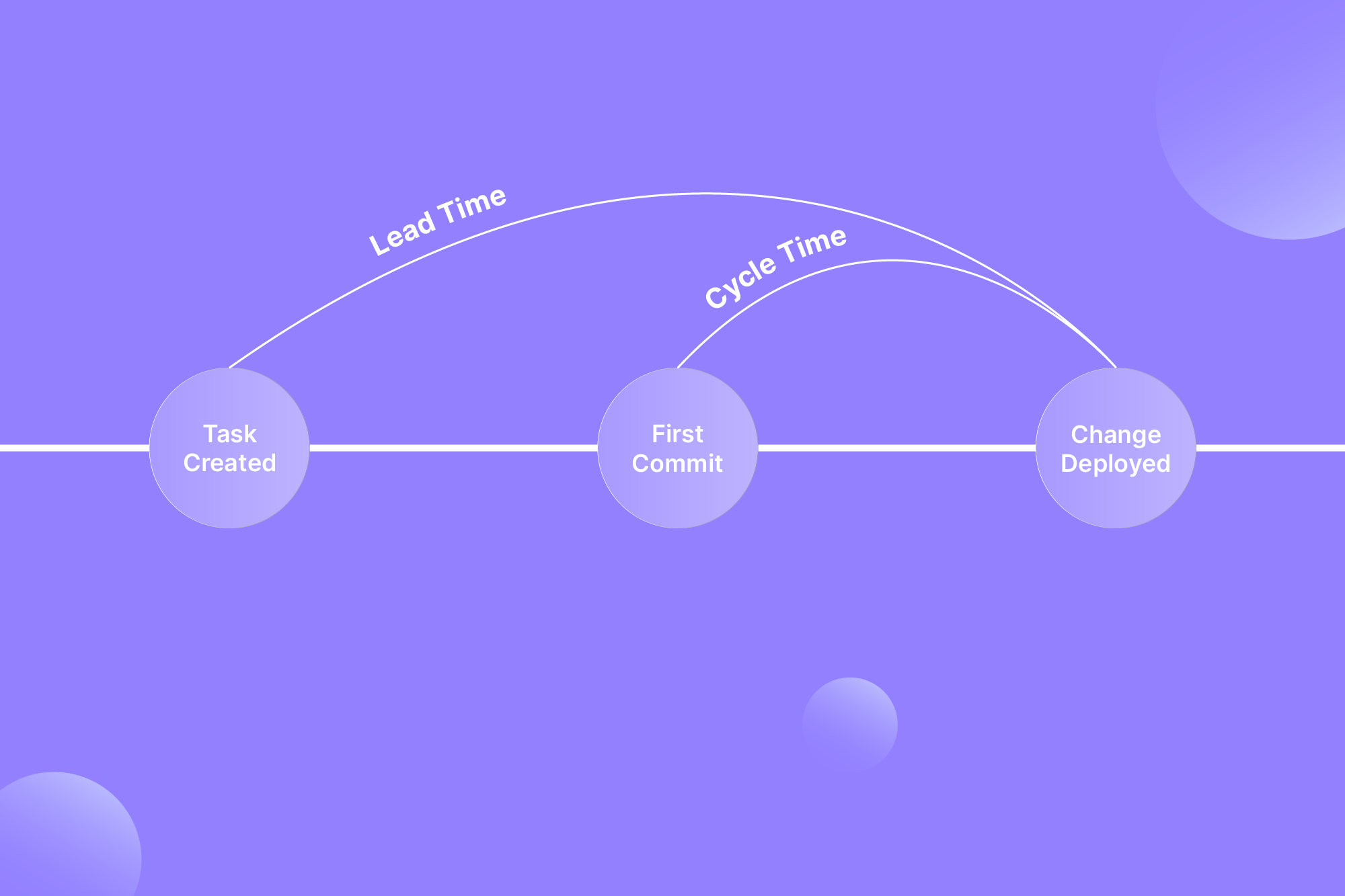Cycle Time vs. Lead Time in software development

It’s true that in engineering organizations (or anywhere really), time is money. Delivering high-quality software quickly is on every engineering manager’s list. That is precisely why the usage of lead time and cycle time metrics is becoming more common amongst engineering teams.
While they may seem somewhat similar, there are some important differences. But how different are they? What do they measure? Why do you need to track them? And how can you optimize these metrics to boost productivity? Let’s jump in to find out.
What is Lead time?
Lead time isn’t inherently related to software development. It’s actually a popular term in inventory management and signifies the time taken from the moment an order was requested to when it was shipped.
In software development, the lead time metric is tweaked to fit software engineering processes. Here, we use lead time as a velocity metric to measure the time from when a requirement is created to the time it’s ready to deliver.
It includes the discussions around the request, the time the requested feature was on the waitlist or backlog, and the time someone picks up on it to the time it’s released.
For instance, your client wants a new payment integration added to their portal. When they put in a request for this feature, the clock starts ticking! So, if after receiving the request, your team was able to deliver the work item in 40 days, then your lead time is 40 days.
What is Cycle time?
Like its counterpart, cycle time is also considered a velocity metric. In manufacturing, it denotes the total time taken to convert raw materials into finished goods.
Along similar lines, cycle time in software engineering calculates the time spent on delivering value to a customer. It measures the time from when a developer starts working on a feature to the time of delivery.
Like lead time, cycle time is also a velocity metric. It can be divided into four elements:
- Coding Time: the time between the first commit made by a developer to the time a pull request is submitted
- Pickup Time: time when a pull request is issued to the time before a review has begun
- Merge Time: time taken to merge changes to existing code base
- Deploy Time: a time when a code is ready to be deployed to production to when it goes live
What do you get out of tracking both metrics?
As we discussed above, both cycle time and lead time help you measure the efficiency of your engineering teams in terms of how quickly they can complete new tasks.
Measuring these metrics allows engineering managers to dig deeper into their team’s workflows and see how smoothly it’s running. They’re also a pretty good way to assess your engineering team’s capability to provide value to clients.
For engineering leaders, lead time is essential because it’s a customer-centric metric that tells you how long it’ll take to deliver value to clients. Other things being equal, a lower lead time means the customer is getting new value faster, which will lead to happier customers.
On the other hand, cycle time is mostly considered an internal metric. However, that doesn’t mean that it doesn’t impact customer satisfaction at all because cycle time is closely linked to lead time. In addition, cycle time is considered organization-focused instead of customer-centric because it calculates the overall efficiency of a process to tell you how much time was spent on a work-in-progress feature. With this metric at your disposal, you can identify any bottlenecks in engineering development processes.
If your cycle time is low but your lead time is high, that could imply that your team is delivering fast, but there may be a capacity problem to pick more items from the backlog. If your team’s cycle time is high, then you need to inspect each phase i.e., coding time, pick-up time, review time, and deploy time to understand what is causing the delay.
The software development arena is a fast-paced one, with every engineering org trying to deliver value to clients quickly. That’s why, as an engineering manager, you should aim to optimize both lead time and cycle time.
How to track lead time and cycle time?
Traditionally, managers would measure lead time and cycle time by checking Jira tickets, glancing through reports, conducting daily stand-ups to gather progress, and then manually calculating the time between when the request was initiated/the work was picked up to when developers completed the request. However, this method is not only painstakingly long, but it’s also prone to manual errors.
Now, with engineering analytics tools such as DevDynamics, these time metrics can be accessed automatically in a single dashboard through integrations with Jira, GitHub, GitLab, and BitBucket.
Differences between lead Time and cycle Time
Lead time and cycle time seem somewhat similar as they’re both velocity metrics. But there are a few differences that set them apart. We’ve outlined the key differentiations in the table below:
Measuring and improving metrics with DevDynamics
Tracking lead time and cycle time metrics is crucial to assess whether your processes function like a well-oiled machine. Reducing them to boost your team’s productivity may seem like a challenge, but with the right tools, it’s all smooth sailing. However, the biggest “iceberg” you’ll probably face is accurately measuring the metrics.
Engineering analytics tools like DevDynamics enable you to measure lead time as well as cycle time (along with many other metrics). Engineering leaders can use our tool to drill down into cycle time or lead time metrics to understand how smoothly your team and projects are functioning. Our solution offers complete visibility into every stage of the software development process and allows engineering organizations tools to monitor your team’s progress on different projects, tasks, and requests. Engineering executives can also set engineering goals from our library to see their teams’ performance on a day-to-day basis.
Using DevDynamics, you can gain insights into the efficiency of your delivery operations and tweak them to accelerate velocity and ensure faster delivery. Our built-in metrics feature automatically extracts data to display several metrics (including DORA metrics, coding time, throughput, and more) on a dashboard without manual input. Moreover, we can help you reduce cycle time and lead time by showing you potential bottlenecks in the process so you can jump in and help anytime.
While the importance of measuring cycle time and lead time is unquestionable, we still suggest you broaden your horizons and track an array of diverse metrics that also impact productivity. But don’t worry; you won’t have to go that far because DevDynamics can help you track them all!
Ready to drive engineering success?

